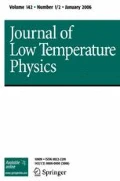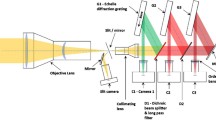Abstract
We present an overview of the design and status of the Polarbear-2 and the Simons Array experiments. Polarbear-2 is a cosmic microwave background polarimetry experiment which aims to characterize the arc-minute angular scale B-mode signal from weak gravitational lensing and search for the degree angular scale B-mode signal from inflationary gravitational waves. The receiver has a 365 mm diameter focal plane cooled to 270 mK. The focal plane is filled with 7588 dichroic lenslet–antenna-coupled polarization sensitive transition edge sensor (TES) bolometric pixels that are sensitive to 95 and 150 GHz bands simultaneously. The TES bolometers are read-out by SQUIDs with 40 channel frequency domain multiplexing. Refractive optical elements are made with high-purity alumina to achieve high optical throughput. The receiver is designed to achieve noise equivalent temperature of 5.8 \(\upmu \)K\(_\mathrm{CMB}\sqrt{s}\) in each frequency band. Polarbear-2 will deploy in 2016 in the Atacama desert in Chile. The Simons Array is a project to further increase sensitivity by deploying three Polarbear-2 type receivers. The Simons Array will cover 95, 150, and 220 GHz frequency bands for foreground control. The Simons Array will be able to constrain tensor-to-scalar ratio and sum of neutrino masses to \(\sigma (r) = 6\times 10^{-3}\) at \(r = 0.1\) and \(\sum m_{\upnu } (\sigma =1)\) to 40 meV.

Similar content being viewed by others
References
J. Beringer et al., Review of particle physics (RPP). Phys. Rev. D 86, 010001 (2012)
P.A.R. Ade et al., A measurement of the cosmic microwave background B-mode polarization power spectrum at sub-degree scales with POLARBEAR. Astrophys. J. 794(2), 171 (2014)
P.A.R. Ade et al., Detection of \(B\)-mode polarization at degree angular scales by BICEP2. Phys. Rev. Lett. 112(24), 241101 (2014)
P.A.R. Ade et al., Evidence for gravitational lensing of the cosmic microwave background polarization from cross-correlation with the cosmic infrared background. Phys. Rev. Lett. 112, 131302 (2014)
P.A.R. Ade et al., Measurement of the cosmic microwave background polarization lensing power spectrum with the POLARBEAR experiment. Phys. Rev. Lett. 113, 021301 (2014)
P.A.R. Ade et al., Bicep2/keck array v: Measurements of b-mode polarization at degree angular scales and 150 ghz by the keck array. Astrophys. J. 811(2), 126 (2015)
D. Hanson et al., Detection of B-mode polarization in the cosmic microwave background with data from the south pole telescope. Phys. Rev. Lett. 111(14), 141301 (2013)
R. Keisler et al., Measurements of sub-degree B-mode polarization in the cosmic microwave background from 100 square degrees of SPTpol data. Astrophys. J. 807(2), 151 (2015)
U. Seljak et al., Signature of gravity waves in the polarization of the microwave background. Phys. Rev. Lett. 78, 2054–2057 (1997)
H. Wayne et al., Mass reconstruction with cmb polarization. Astrophys. J. 574, 566–574 (2002)
P.A.R. Ade et al., Joint analysis of BICEP2/keck array and Planck data. Phys. Rev. Lett. 114, 101301 (2015)
Planck Collaboration. Planck intermediate results. xxx. the angular power spectrum of polarized dust emission at intermediate and high galactic latitudes. A&A (2015)
J. Errard et al., Framework for performance forecasting and optimization of cmb \(b\)-mode observations in the presence of astrophysical foregrounds. Phys. Rev. D 84, 063005 (2011)
Yuki Inoue et al., Cryogenic infrared filter made of alumina for use at millimeter wavelength. Appl. Opt. 53(9), 1727–1733 (2014)
Darin Rosen et al., Epoxy-based broadband antireflection coating for millimeter-wave optics. Appl. Opt. 52(33), 8102–8105 (2013)
O. Jeong et al., Broadband plasma sprayed anti-reflection coating for millimeter-wave astrophysics experiments. J. Low Temp. Phys., this Special Issue. doi:10.1007/s10909-015-1442-3
A. Suzuki et al., Multi-chroic dual-polarization bolometric detectors for studies of the cosmic microwave background. J. Low Temp. Phys. 176(5–6), 650–656 (2014)
P. Siritanasak et al., The broadband anti-reflection coated extended hemispherical silicon lenses for polarbear-2 experiment. J. Low Temp. Phys., this Special Issue. doi:10.1007/s10909-015-1386-7
K. Hattori et al., Development of readout electronics for polarbear-2 cosmic microwave background experiment. J. Low Temp. Phys., this Special Issue. doi:10.1007/s10909-015-1448-x
M.A. Dobbs et al., Frequency multiplexed superconducting quantum interference device readout of large bolometer arrays for cosmic microwave background measurements. Rev. Sci. Instrum. 83(7), 073113 (2012)
A.N. Bender et al., Digital frequency domain multiplexing readout electronics for the next generation of millimeter telescopes (2014)
K. Rotermund et al., Planar lithographed superconducting lc resonators for frequency-domain multiplexed readout systems. J. Low Temp. Phys., this Special Issue
Acknowledgments
We acknowledge the support from the MEXT Kahenhi Grant 21111002, NSF Grant AST-0618398, NASA Grant NNG06GJ08G, The Simons Foundation, Natural Sciences and Engineering Research Council, Canadian Institute for Advanced Research, and Japan Society for the Promotion of Science, and the CONICYT provided invaluable funding and support. Detectors were fabricated at the Berkeley Marvell Nanofabrication laboratory.
Author information
Authors and Affiliations
Corresponding author
Rights and permissions
About this article
Cite this article
Suzuki, A., Ade, P., Akiba, Y. et al. The Polarbear-2 and the Simons Array Experiments. J Low Temp Phys 184, 805–810 (2016). https://doi.org/10.1007/s10909-015-1425-4
Received:
Accepted:
Published:
Issue Date:
DOI: https://doi.org/10.1007/s10909-015-1425-4




